Fresh Mango Salsa is a must-have in South Florida. This vibrant blend of finely diced mangoes, jalapenos, red bell pepper, lime juice, zest, and fresh-cut cilantro delivers an irresistible combination of sweet and spicy flavors.
And the best part? It’s incredibly simple to prepare, allowing you to effortlessly whip up another batch once it disappears—trust me, it disappears fast! Bring it to any gathering, and you’ll be lucky if there’s any left by the time you make it around the buffet table.
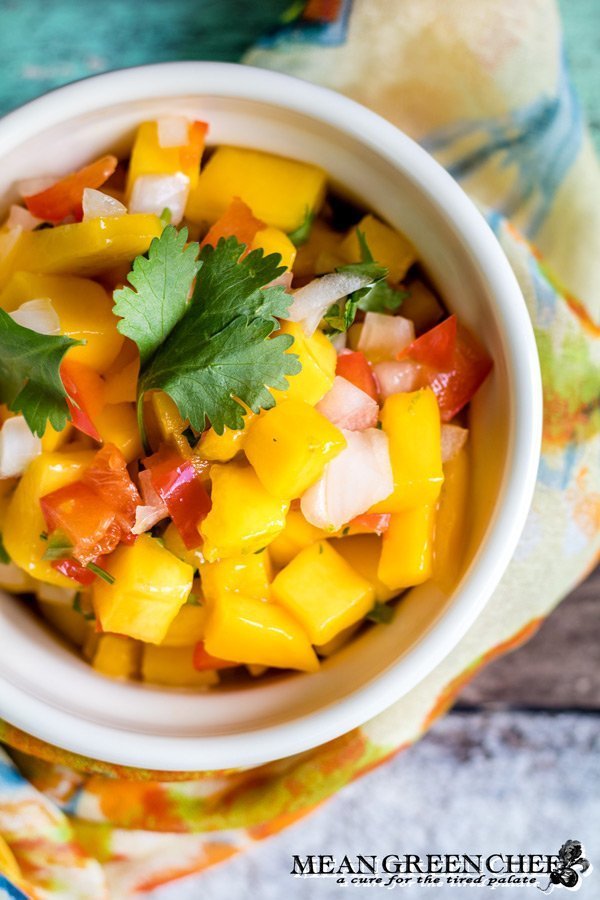
When in Florida, we honor the beloved mango with the Mango Mania Festival right here on the Island. Enthusiasts from far and wide gather to indulge in over 20 distinct varieties of this tropical fruit. This inspiring summer event unfolds over two weekends, attracting thousands of attendees and offering a delightful array of taste sensations!
Don’t miss out—plan a trip to join in on this festive celebration! With our breathtaking sunsets and teeming tarpon-filled waters, the experience is truly worth the journey. We’ll be waiting to welcome you with open arms!
carte du jour
ToggleA Mango Lover's Guide: How to Choose the Best Mangoes
Look for Color: Opt for mangoes with vibrant hues, ranging from golden yellow to reddish-orange. Avoid green mangoes, as they are likely underripe.
Check for Firmness: Gently squeeze the mango to assess its firmness. A ripe mango should yield slightly to pressure without feeling too soft or mushy.
Sniff the Stem End: Take a whiff of the stem end of the mango. A sweet, fruity aroma indicates ripeness, while a lack of scent suggests the mango may still need time to ripen.
Examine the Skin: Inspect the skin for any blemishes, bruises, or wrinkles. Choose mangoes with smooth, unblemished skin for the best quality.
Consider Variety: Different mango varieties have unique flavors and textures. Experiment with varieties such as Alphonso, Ataulfo, or Kent to discover your favorite.
Weight Matters: Heavier mangoes typically indicate juiciness and ripeness. Pick up the mango and assess its weight relative to its size.
Give it Time to Ripen: If you can’t find ripe mangoes at the store, purchase slightly underripe ones and allow them to ripen at room temperature for a few days. Placing them in a paper bag can help speed up the ripening process.
Avoid Bruising: Handle mangoes with care to prevent bruising. Bruises can accelerate spoilage and affect the taste and texture of the fruit.
By following these tips, you’ll be sure to select the perfect mangoes for enjoying fresh or incorporating into your favorite recipes.
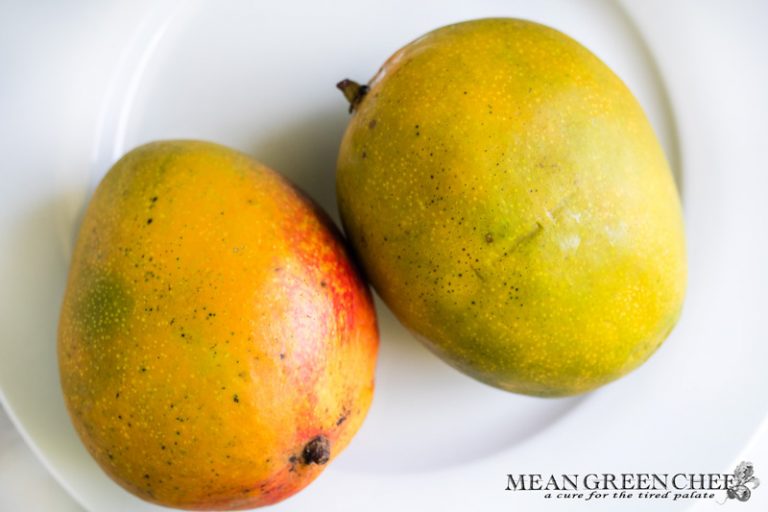
Exceptions to the typical ripeness indicators include:
Tommy Atkins Mango: This variety does not undergo significant color changes as it ripens. It’s best utilized in sour recipes, particularly for pickling, regardless of its color.
Ataulfo Mango: Even when fully ripe, the Ataulfo mango may not emit a strong fragrance or sap. Instead, its ripeness is indicated by a wrinkled appearance, making it easy to identify when it’s ready to enjoy.
There are hundreds of mango varieties cultivated around the world, each with its own unique flavor, texture, and appearance. While it’s difficult to provide an exact number due to the vast diversity of mango cultivars, some estimates suggest there are over 1,000 different varieties.
Mango varieties are typically categorized into two main types:
Indian Varieties: These mangoes are native to the Indian subcontinent and are known for their rich flavor and aromatic qualities. Some popular Indian varieties include Alphonso, Kesar, Banganapalli, Totapuri, and Dasheri.
Indochinese Varieties: Originating from Southeast Asia, these mangoes are valued for their sweetness and smooth texture. Common Indochinese varieties include Nam Doc Mai, Keitt, Manila, and Ataulfo (also known as Honey or Champagne mango).
Additionally, there are hybrid varieties and cultivars that have been developed through crossbreeding to enhance specific characteristics such as disease resistance, size, or flavor profile. These hybrids may combine traits from both Indian and Indochinese mango varieties, resulting in an even wider range of options for mango enthusiasts.
Overall, the diversity of mango varieties offers an exciting array of flavors and experiences, ensuring that there’s a mango variety to suit every palate and preference.
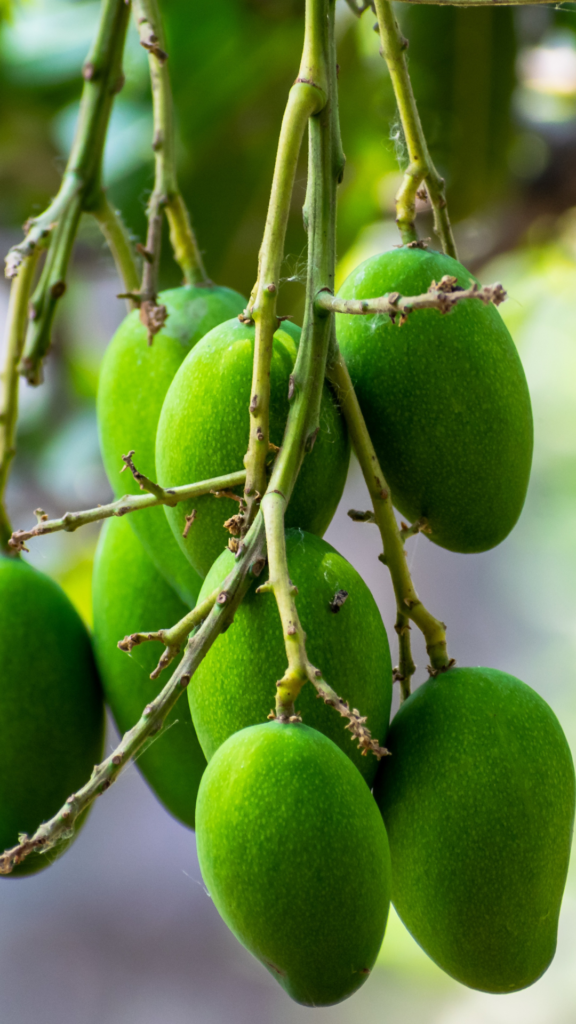
Interesting Mango Facts
- Mangoes, cashews, and pistachios are all related as they belong to the same plant family, Anacardiaceae.
- Mangoes (Mangifera indica) are large, tropical fruits known for their sweet and juicy flesh.
- Cashew trees (Anacardium occidentale) produce cashew nuts, which are the seeds found within the cashew apple fruit.
- Pistachio trees (Pistacia vera) yield pistachio nuts, which are the seeds found within the small, elongated fruits known as drupes.
- While mangoes, cashews, and pistachios may differ in appearance and taste, they share a botanical relationship through their membership in the Anacardiaceae family.

Tips for Safely Storing Mangoes
Store at Room Temperature: Keep unripe mangoes at room temperature to allow them to ripen naturally. Once ripe, they can be stored in the refrigerator to prolong freshness.
Avoid Direct Sunlight: Store mangoes away from direct sunlight, as excessive heat can cause them to ripen too quickly and become overripe.
Separate from Ethylene Producers: Keep mangoes away from ethylene-producing fruits such as apples, bananas, and tomatoes, as ethylene can speed up the ripening process.
Refrigerate Ripe Mangoes: Once ripe, transfer mangoes to the refrigerator to slow down the ripening process and extend their shelf life. Place them in the crisper drawer or a perforated plastic bag to maintain optimal humidity levels.
Handle with Care: Handle mangoes gently to avoid bruising, which can lead to spoilage and affect their quality. Avoid stacking heavy items on top of mangoes during storage.
Use airtight containers: Store cut mangoes in an airtight container or wrap them tightly in plastic wrap to prevent them from drying out and absorbing odors from other foods in the refrigerator.
Consume Promptly: Fresh mangoes are best enjoyed within a few days of ripening. Be sure to check for signs of spoilage, such as mold or off-putting odors, before consuming.
How to Safely Cut Mangoes
Several methods ensure safe mango cutting, but my preferred technique, outlined below, yields finely diced mangoes. Regardless of your chosen method, always ensure you’re using a sharp knife. Dull knives pose a significant risk of kitchen injuries.
- Peel the skin off the mangoes with a sharp knife or veg peeler.
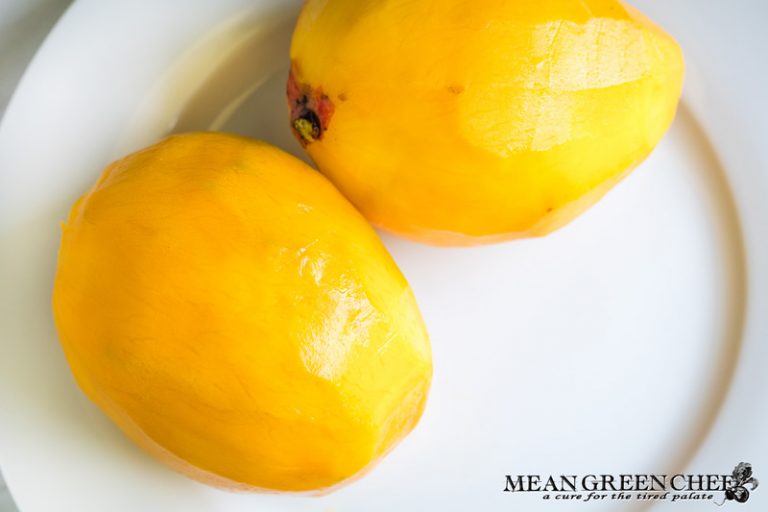
- Slice off the bottom of the mangoes so they can stand on end easily.

- Now thinly slice down the cheek (the wide flat part on each side) until you get close to the stone. The trim down each of the sides to remove any excess meat.

- Once this is done with both mangoes cut into a 1/4 inch dice and toss into a bowl and proceed to the recipe or eat anyway you like!
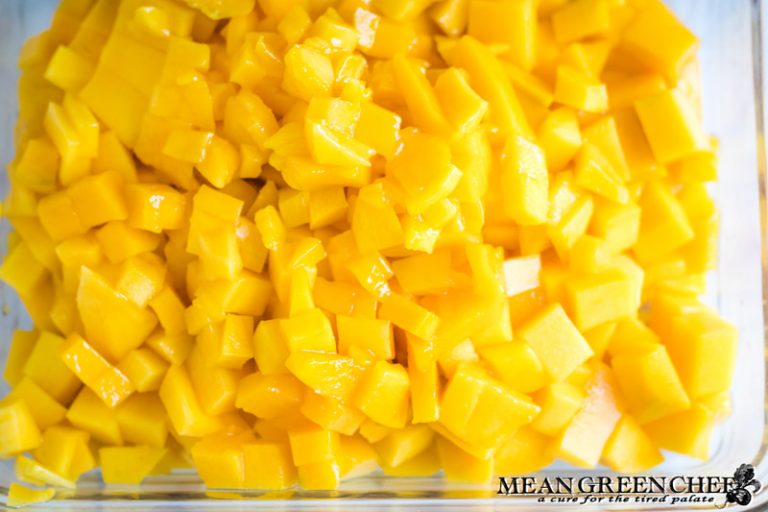
Versatile Uses for Fresh Mango Salsa
- Topping: Use fresh mango salsa as a topping for grilled chicken, fish tacos, or pork chops to add a burst of tropical flavor.
- Dipping: Serve mango salsa as a refreshing dip alongside tortilla chips, pita chips, or crispy plantain chips for a tasty appetizer.
- Salad: Incorporate mango salsa into green salads or grain salads for a sweet and tangy twist. It pairs well with spinach, arugula, quinoa, or couscous.
- Sauce: Use mango salsa as a sauce for grilled shrimp skewers, seared scallops, or baked salmon to infuse dishes with vibrant color and flavor.
- Wrap Filling: Spread mango salsa onto tortillas or wraps before adding grilled chicken, black beans, avocado, and lettuce for a flavorful and satisfying meal.
- Sides: Serve mango salsa as a side dish alongside grilled meats, seafood, or vegetarian dishes to brighten up the plate and provide a refreshing contrast.
- Topping for Breakfast: Spoon mango salsa over scrambled eggs, omelets, or avocado toast for a tropical twist on your morning meal.
- Garnish: Use mango salsa as a colorful garnish for soups, chili, or rice bowls to add visual appeal and a burst of fruity flavor.
- Marinade: Mix mango salsa with olive oil, lime juice, and spices to create a vibrant marinade for chicken, fish, or tofu before grilling or baking.
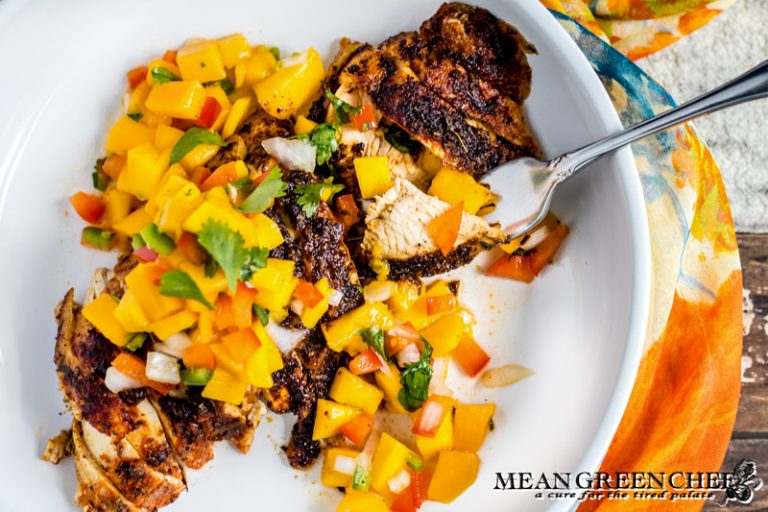
Please Pin to Make & Share!📌

Preserving Tropical Flavor: Storing Mango Salsa for Lasting Freshness
Here’s how to store mango salsa to maintain its vibrant flavor:
Refrigeration: Store mango salsa in an airtight container in the refrigerator to maintain its freshness. The cool temperature helps to slow down bacterial growth and preserve the quality of the salsa.
Airtight Container: Transfer the mango salsa to a clean, airtight container. Make sure the container is sealed tightly to prevent air from entering and causing the salsa to spoil faster.
Avoiding Contamination: Use clean utensils and avoid double-dipping to prevent contamination of the salsa. This helps to extend its shelf life and maintain its quality.
Stir Before Serving: Before serving, give the mango salsa a gentle stir to redistribute the ingredients. This ensures that the flavors are evenly distributed and enhances the overall taste.
Shelf Life: When stored properly in the refrigerator, mango salsa can last for about 3-5 days. However, for the best taste and texture, it’s recommended to consume it within 2-3 days of preparation.
By following these storage guidelines, you can enjoy the fresh and vibrant flavors of mango salsa for several days, whether as a topping for grilled meats, a dip for tortilla chips, or a flavorful addition to tacos and salads.
How to Make Fresh Mango Salsa

Fresh Mango Salsa
Ingredients
- 2 large (3 cups) ripe mangoes, peeled + ¼ inch dice
- 2 medium jalapenos (or to taste), scrubbed + ¼ inch dice
- 1 medium red pepper, scrubbed + ¼ inch dice
- 1 small white or red onion, topped + peeled + ¼ inch dice
- ½ cup fresh cilantro, washed + dried + loosely packed
- 1 large lime, zest + juice
- ½ teaspoon pink Himalayan sea salt or Kosher sea salt, to taste (finely ground)
- fresh cracked black pepper, to taste
Instructions
- Add diced mangoes to a bowl..

- Add the jalapenos...

- Then toss in the red pepper, onions, cilantro, lime zest, and juice...

- Gently stir, season with salt + pepper to taste. Cover and refrigerate 15 minutes and up 4 hours to allow flavors to marry.

- Serve with fresh plantain chips or as desired, shown here topping our Blackened Chicken.

Notes
- Prep time is approximate, depeding on knife skills. Please be sure to use a sharp knife, dull knives are dangerous!
- Can be served immediatly but allowing the flavors to marry creates an even better salsa.
- Store in an airtight container up to 3 days in the refirgerator.
Creative Recipe Inspiration
Looking for more Salsa Recipe inspiration? You’ll definitely want to check out our Authentic Restaurant Style Red Salsa….
or our Amazing Roasted Salsa Verde, roasted to perfection and then blended into creamy dreamy salsa that will leave everyone wanting more!
Step Into My Kitchen!
Hey there, fellow food enthusiast! Welcome to Mean Green Chef, where every dish tells a story and every recipe is a labor of love. I’m thrilled to share a bit about myself and the journey that led me here, stirring pots and sprinkling spices for over three decades!


Just a quick heads up – you might notice some affiliate links sprinkled throughout our site. If you decide to click on them and make a purchase, rest assured, it won’t cost you extra. Instead, you’ll be helping to support our blog and keep the kitchen fires burning. Thanks a bunch for your support!








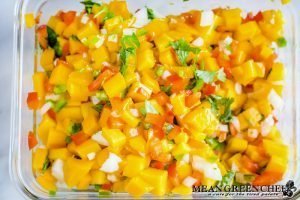






This was the BEST mango salsa! Light and delicious and paired very well with Mahi Mahi with your blackened seasoning. LOVE your recipes, Angela!
So excited that you enjoyed our recipe, Ramae! Plus the fact you paired it with our Badass Blackened Seasoning on Mahi sounds perfect, so glad that you enjoyed it! 😀
This looks so good! I love mango salsa and can’t wait to try your recipe.
Thanks so much, Cindy! Can’t wait to hear how you like it 🙂
I love all your tips on selecting the perfect mango and how to properly cut one. Last time I cut up a mango the mango won!
LOL, it can happen, they’re slippery little suckers, Erika! I do love cutting off the bottom so you can stand it on end to slice, works like a charm! 🙂
I just made this with the blackened chicken and it was soooo good. Will be making again.
Awesome, Jessica, so glad to hear that you will be making it again! Thank you so much for taking the time to let us know how it turned out for you 😀
Great salsa! Served with blackened grouper using your BadAss seasoning mix. I added some diced avocado to the salsa but it disintegrated while allowing the salsa to meld. Next time I’ll use an avocado that is less ripe and add it just before serving.
So glad that you enjoyed this salsa and my Badass Blackened Seasoning too! Thank you so much!